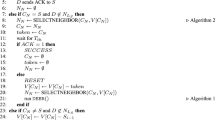Abstract
Prolonging the network lifetime is a crucial constraint in wireless sensor networks. Since data communication requires a more energy consumption than any other process, sensor nodes necessitate an energy efficient communication. Most related works generally consider the propagation path loss model to capture the channel effects for the energy consumption model and the routing metric choice. Nevertheless, this model does not incorporate the small-scale fading. Thus, it is inaccurate to evaluate link reliability. In this paper, we derive the analytical expression of the energy consumption by including the small-scale channel fading and its impact on energy efficiency. Then, we propose a cross-layer approach based on joint network and physical layers by including small and large scale fading. We improve the ad hoc on-demand distance vector protocol at the route discovery mechanism and the data transmission by considering both SNR and residual energy thresholds, and a power adjustment algorithm. Simulation results show that the proposed cross-layer approach significantly prolongs the network lifetime while guaranteeing a communication efficiency level.


Similar content being viewed by others
References
Lee, S., & Lee, H. (2010). Analysis of network lifetime in cluster-based sensor networks. IEEE Wireless Communications, 14(10), 900–902.
Ren, J., Zhang, Y., & Liu, K. (2013). An energy-efficient cyclic diversionary routing strategy against global eaves droppers in wireless sensor networks. International Journal Distributed Sensor Networks, 2013, 1–16.
Akyildiz, I. F., Vuran, M. C., & Akan, O. B. (2006). A cross-layer protocol for wireless sensor networks. In 40th annual conference on information sciences and systems (pp. 1102–1107).
van Hoesel, L., Nieberg, T., Wu, J., & Havinga, P. J. M. (2004). Prolonging the lifetime of wireless sensor networks by cross-layer interaction. IEEE Wireless Communications, 11(6), 78–86.
Royer, E. M., & Perkins, C. E. (2000). An implementation study of the AODV routing protocol. In Wireless Communications and Networking Confernce (WCNC) (pp. 1003–1008).
Ren, S., Han, H., Li, B., Lu, J., Peng, C., & Dou, W. (2012). An improved wireless sensor networks routing protocol based on AODV. In IEEE international conference on computer and information technology (pp. 742–746).
Chudasama, S. D., & Trapasiya, S. R. (2014). Packet size optimization in wireless sensor network using cross-layer design approach. In IEEE international conference on advances in computing, communications and informatics (ICACCI) (pp. 2506–2511).
Zhang, L., & Zhang, Y. (2009). Energy-efficient cross-layer protocol of channel-aware geographic-informed forwarding in wireless sensor networks. IEEE Transactions on Vehicular Technology, 58(6), 3041–3052.
Park, J., Moh, S., & Chung, I. (2008). A multipath AODV routing protocol in mobile ad hoc networks with SINR-based route selection. In IEEE international symposium on wireless communication systems. ISWCS ’08 (pp. 682–686).
Ben-Othman, J., & Yahya, B. (2010). Energy efficient and QoS based routing protocol for wireless sensor networks. Journal of Parallel and Distributed Computing, 70(8), 849–857.
Wieselthier, J. E., Nguyen, G. D., & Ephremides, A. (2000). On constructing minimum spanning trees in k-dimensional spaces and related problems. In Proceedings of Infocom (pp. 585–594).
Lin, S., Zhang, J., Zhou, G., Gu, L., He, T., & Stankovic, J. A. (2006). ATPC: Adaptive transmission power control for wireless sensor networks. In ACM conference on embedded networked sensor systems (pp. 223–236).
Simon, M. K., & Alouini, M. S. (2004). Digital communications over fading channels (2nd ed.). New York: Wiley.
Ren, J., Zhang, Y., Zhang, K., Liu, A., Chen, J., & Shen, X. (2016). Lifetime and energy hole evolution analysis in data-gathering wireless sensor networks. IEEE Transactions on Industrial Informatics, 12(2), 788–800.
Vuran, M. C., & Akyildiz, I. F. (2010). XLP: A cross-layer protocol for efficient communication in wireless sensor networks. IEEE Transactions on Mobile Computing, 9(11), 1578–1591.
Author information
Authors and Affiliations
Corresponding author
Rights and permissions
About this article
Cite this article
Ben Ammar, A., Dziri, A., Terre, M. et al. Cross-Layer Approach Based Energy Minimization for Wireless Sensor Networks. Wireless Pers Commun 98, 2211–2221 (2018). https://doi.org/10.1007/s11277-017-4970-0
Published:
Issue Date:
DOI: https://doi.org/10.1007/s11277-017-4970-0




